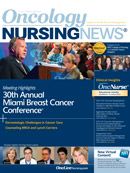Publication
Article
Oncology Nursing News
Cancer Treatment-It's Personal Now
Author(s):
The majority of the new oncology drugs approved in 2012 are oral agents, and by reviewing the indications for these agents, it's easy to see how genetics impacts the agent's efficacy.
Lisa Schulmeister, RN, MN, APRN-BC, OCN®, FAAN
Editor-in-Chief OncLive Nursing
Oncology Nursing Consultant, Adjunct Assistant Professor of Nursing Louisiana State Health Sciences Center in New Orleans, Louisiana
The human genome was fully sequenced about a decade ago, and since that time, personalized medicine has taken off, not only in oncology practice but in other treatment areas as well. Gone are the days of “one-size-fits-all” treatments, when tissue pathology dictated what treatment would be administered to all of the people who happened to have the same type of cancer and stage of disease. Genetic testing, along with the development and refinement of targeted agents, now enable patients to receive personalized cancer treatment.
Advances in understanding the biology and treatment of cancer also are responsible for reducing clinical trial costs, identifying effective (and ineffective) treatments earlier, and increasing the number of FDA approvals. The FDA approved 11 new oncology drugs in 2012, the most in any medical category. Seven of these new drugs are oral agents, three are given intravenously, and one is given subcutaneously.
Because the efficacy of targeted agents often is known early in the clinical trial process, FDA review time has decreased, and the agency has even created a new approval designation. The FDA’s Safety and Innovation Act created the “breakthrough” designation for agents that are significant improvements over existing treatments. To qualify for breakthrough status, a new drug/agent must meet the criteria that it must be intended for a serious or life-threatening disease and supported by preliminary clinical evidence that indicates that it may demonstrate substantial improvement over existing therapies on one or more clinically significant endpoints, such as substantial treatment effects observed early in clinical development.
The FDA’s new breakthrough designation allows new drugs to win approval after just a single round of testing, instead of the usual three. As of March 2013, three promising investigational drugs have been assigned the new status so far, including ibrutinib for mantle cell lymphoma and Waldenström’s macroglobulinema, and 18 additional drugs are in the application process. The new breakthrough designation follows three other programs— Fast Track, Priority Review, and Accelerated Approval— each of which were designed to help bring critically needed new drugs to market in a shorter amount of time.
One key to faster drug approval is that many of the new agents are targeted therapies that have more defined, precise targets. Fewer patients are needed to get definitive results in early trials because they are selected only if their tumors contain proteins or gene mutations that the experimental drug is targeting. Consequently, higher levels of response are being observed, even in phase I trials.
The majority of the new oncology drugs approved in 2012 are oral agents, and by reviewing the indications for these agents, it’s easy to see how genetics impacts the agent’s efficacy. For instance, ponatinib (Iclusig) is an oral drug used to treat patients with chronic myeloid leukemia or Philadelphia-chromosome-positive acute lymphoblastic leukemia who are resistant to other therapies, and in those who carry T315I mutations.
Because oral chemotherapy and targeted agents are self-administered or administered by a family member or other lay caregiver, there are safety concerns. First, the patient needs to be assessed to determine if he or she can even ingest and tolerate an oral agent. Next, the oral agent needs to be stored and handled properly. Then, the right drug and dose need to be taken at the right time in the right way. And lastly, the patient needs to be instructed on symptoms to report and monitored for adherence to oral therapy.
Oncology providers have a different role now than in the past, when virtually all chemotherapy drugs were given intravenously. We now assess for drug—drug, drug–food, drug–supplement, and drug–complementary therapy interactions. We also determine the best way for the patient to receive the oral agent. Navigating the procurement and payment system for oral agents has become a full-time job in many practices. And perhaps the biggest change of all is that we are teaching patients how to take oral chemotherapy and targeted agents, instead of administering these agents ourselves.









